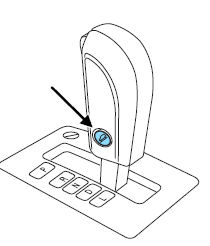Automatic transmission operation (if equipped)
Automatic transmission adaptive learning
Your transmission is equipped with an adaptive learning strategy found in the vehicle computer. This feature is designed to increase durability and provide consistent shift feel over the life of the vehicle. A new vehicle or transmission may have firm and/or soft shifts. This operation is considered normal and will not affect function or durability of the transmission. Over time, the adaptive learning process will fully update transmission operation. Additionally, whenever the battery is disconnected or a new battery installed, the strategy must be relearned.
Understanding the gearshift positions of the 6–speed automatic transmission
Your vehicle has been designed to improve fuel economy by reducing fuel usage while coasting or decelerating. When you take your foot off the accelerator pedal and the vehicle begins to slow down, the torque converter clutch locks up and aggressively shuts off fuel flow to the engine while decelerating. This fuel economy benefit may be perceived as a light to medium braking sensation when removing your foot from the accelerator pedal.
P (Park)
This position locks the transmission and prevents the front wheels from turning.
To put your vehicle in gear:
1. Press the brake pedal.
2. Move the gearshift lever into the desired gear.
To put your vehicle in P (Park):
1. Come to a complete stop.
2. Move the gearshift lever and securely latch it in P (Park).

![]() WARNING:
Always set the parking brake fully and make sure the gearshift is latched in P (Park).
Turn the ignition to the off position and remove the key whenever you leave your
vehicle.
WARNING:
Always set the parking brake fully and make sure the gearshift is latched in P (Park).
Turn the ignition to the off position and remove the key whenever you leave your
vehicle.
R (Reverse)
With the gearshift lever in R (Reverse), the vehicle will move backward.
Always come to a complete stop before shifting into and out of R (Reverse).
N (Neutral)
With the gearshift lever in N (Neutral), the vehicle can be started and is free to roll. Hold the brake pedal down while in this position.
D (Drive) with Overdrive
The normal driving position for the best fuel economy. Transmission operates in gears one through six.
D (Drive) with Grade Assist
Pressing the transmission control switch on the side of the gearshift lever activates grade assist and cancels overdrive.
• Provides additional grade (engine) braking and extends lower gear operation
on uphill climbs for hilly terrain or mountainous areas.
• Provides additional engine braking through the automatic transmission shift strategy
which reacts to vehicle inputs (vehicle acceleration, accelerator pedal, brake pedal
and vehicle speed).
• Allows the transmission to select gears that will provide the desired engine braking
based on the vehicle inputs mentioned above. This will increase engine RPM during
engine braking.
• The grade assist lamp in the instrument cluster is illuminated.

Grade assist is designed to aid the driver with optimal gear selection in hilly terrain or mountainous areas but is not intended for normal operation. It is recommended that you return to O/D (overdrive mode) on flat terrain to provide the best fuel economy and transmission function.

To return to normal D (Drive) position (with O/D), press the transmission control switch again.
• The grade assist lamp in the instrument cluster will not be illuminated.
• The transmission will operate in gears one through six.
O/D (overdrive mode) is automatically returned each time the engine is turned off.
L (Low)
• Provides maximum engine braking.
• Will downshift to the lowest available gear for the current vehicle speed; allows
for first gear when vehicle reaches slower speeds.
• Is not intended for use under extended or normal driving conditions and results
in lower fuel economy.
If your vehicle gets stuck in mud or snow
Note: Do not rock the vehicle if the engine is not at normal operating temperature or damage to the transmission may occur.
Note: Do not rock the vehicle for more than a minute or damage to the transmission and tires may occur, or the engine may overheat.
If your vehicle gets stuck in mud or snow, it may be rocked out by shifting between forward and reverse gears, stopping between shifts in a steady pattern. Press lightly on the accelerator in each gear.
See also:
Supplementary Restraints System
Principles of operation
WARNING: Airbags do not inflate slowly or gently, and the risk of injury
from a deploying airbag is the greatest close to the trim covering the airbag module.
WARNING: All ...
Seats
Sitting in the correct position
WARNING: Sitting improperly out of position or with the seat back reclined
too far can take off weight from the seat cushion and affect the decision of the
passen ...
Rear-view camera system
WARNING: The rear view camera system is a reverse aid supplement device
that still requires the driver to use it in conjunction with the interior and exterior
mirrors for maximum coverage.
WARNIN ...
